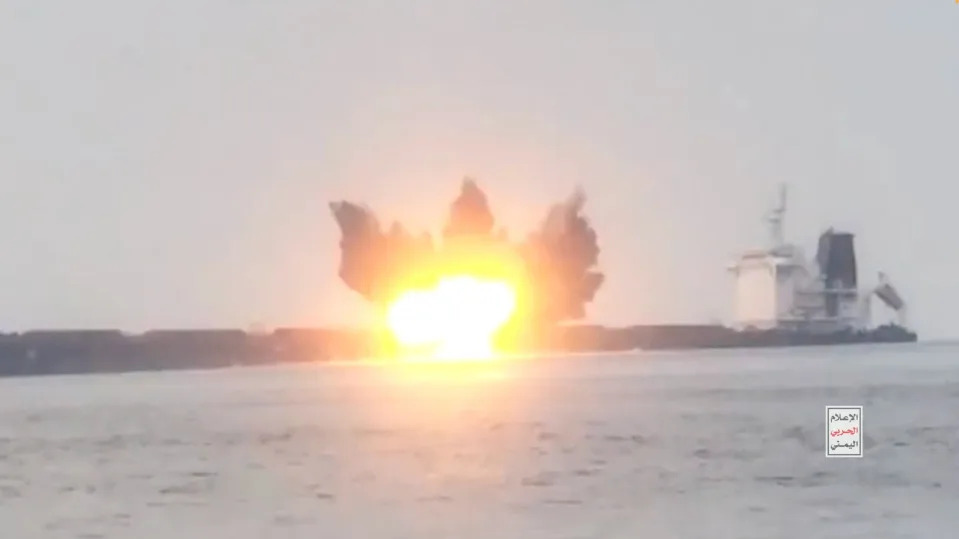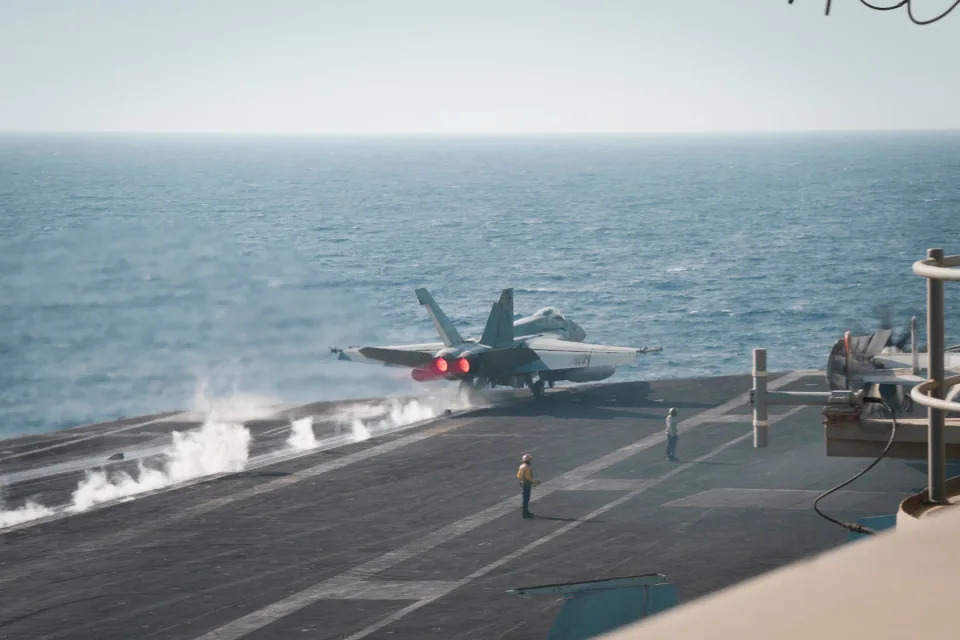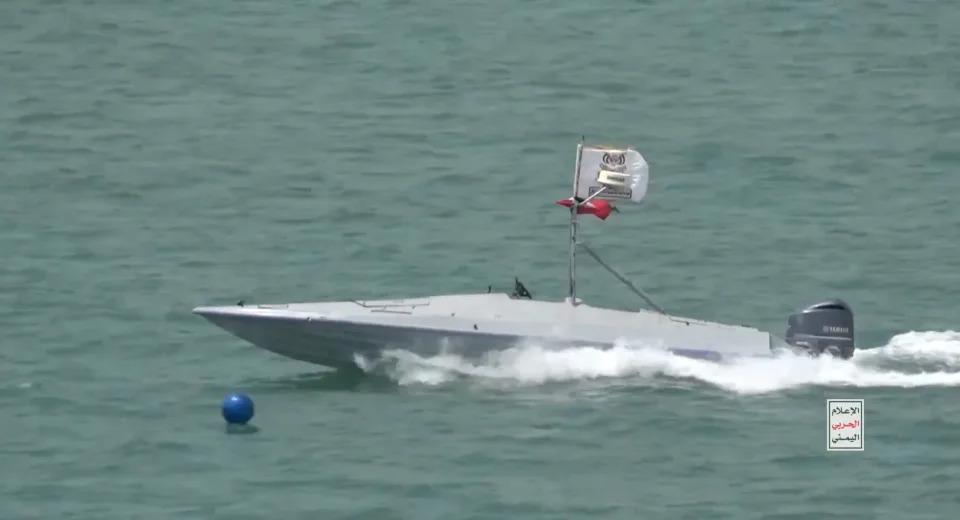Houthi bomb boats, including some not seen before, are threatening Red Sea ships while the US Navy's aircraft carriers are away

-
The Houthis have stepped up their attacks and intimidation efforts with their drone boats.
-
In their latest messaging, the rebels shared a new video of a previously unseen system in action.
-
The uptick comes as the US Navy lacks an aircraft carrier in the region.
The US Navy is in the middle of changing up its forces in the Middle East. An aircraft carrier that spent months in the counter-Houthi fight heads home, leaving a gap as another one makes its way toward the region to take over.
It has been over a week since the US last had an aircraft carrier on station in the Red Sea, meaning the Pentagon can't depend on the routine combat air patrols and immense firepower having a carrier in the region has provided over the past seven months.
The Houthis have been stepping up drone boat operations, employing small watercraft that can be packed with explosives and detonate on impact. These weapons can be used to strike merchant vessels and cause catastrophic damage, which has already been the case in at least one instance in recent weeks.
Drone boats are not a new capability for the Houthis. They have employed them in years past and throughout their ongoing campaign of attacks on merchant vessels and commercial shipping lanes.
During the first few months of the year, US airstrikes in Yemen destroyed the drone boats nearly every time the Houthis tried to send them into the water. But in June, the Iran-backed rebels managed to launch well over a dozen crafts — far more than they had in any previous month. Last month, one of the Houthi drone boats struck a commercial vessel, the MV Tutor, for the first time since the campaign began in November.

In the June 12 attack, the Houthis used a small, slow-moving boat staffed with two dummies, appearing to disguise the crude-looking weapon as a common fishing craft. Hours after the initial strike, the rebels hit the Tutor with a missile, causing it to later sink.
More than a week after the Tutor attack, on June 22, the Dwight D. Eisenhower Carrier Strike Group, which spent more than seven months battling the Houthis, finally left the region to head home, bringing with it the carrier Ike and dozens of fighter aircraft.
The Ike's eventual replacement — the Theodore Roosevelt Carrier Strike Group — won't arrive for some time. And in the meantime, the Houthis appear to be taking advantage of the decreased US Navy air patrols and employing more drone boats.
AfriPrime App link: FREE to download...
https://www.amazon.com/Africircle-AfriPrime/dp/B0D2M3F2JT

United Kingdom Maritime Trade Operations, an element of the British Royal Navy, has reported multiple incidents over the past few days that appear consistent with such attacks.
On June 27, for instance, UKMTO cited one threat as a "waterborne improvised explosive device," and on June 30, it said a merchant vessel was approached by "a mixture of fast boats and smaller kayak-type boats," adding that "some were observed as uncrewed."
On June 30, the Houthi rebels revealed what they said is a highly advanced drone boat that can travel at speeds of 45 nautical mph and deliver an explosive payload of up to 3,300 pounds. The group claimed to have used the drone boat in a June 23 attack on the MV Transworld Navigator and published footage purporting to show the unmanned craft strike the much larger merchant vessel.
Business Insider was unable to immediately verify the Houthi claim. US Central Command said at the time that the Transworld Navigator was hit by a "suspected uncrewed aerial system" and did not mention a drone boat.

In the June 30 video, the Houthis also showed the drone boat going through various maneuvers and training exercises. At one point, rebels can be seen manually operating the craft before they dive off the side into the water and allow it to be remotely piloted.
The newly revealed drone boat is far more sophisticated-looking than the one that struck the Tutor and appears notably larger than unmanned crafts that the rebels publicized and tested earlier in June, underscoring the different capabilities that the Houthis have in their arsenal.
Experts have said that the uptick in drone boat attacks and the Houthis' newfound success in striking commercial vessels with such weapons indicates that they're learning from their many months of attacks and are able to adjust their operations accordingly.
AfriPrime App link: FREE to download...
https://www.amazon.com/Africircle-AfriPrime/dp/B0D2M3F2JT
US struggles to deter Houthi threat as crisis spirals
After half a year of conflict, the U.S. has failed to deter the Houthi rebels from attacking merchant ships in the Red Sea as the Yemeni fighters continue to sink commercial boats and disrupt global trade, posing an increasingly difficult challenge for the far larger American military.
Repeated U.S. bombardments on Houthi positions have done little to stop the Iran-backed group that has managed to employ advanced weapons like surface-water drones and anti-ship ballistic missiles to fluster U.S. troops. And they have kept up the pace of attacks with more than 190 drone and missile launches since the effort began in late October.
While the U.S. has thwarted most Houthi attempts to damage merchant ships, the Yemeni fighters have now sunk or heavily damaged at least four commercial vessels, along with hijacking one. They have also killed four commercial sailors.
The latest successful attack came June 23, when the Houthis struck the Liberian-flagged and Greek-owned merchant ship the Trans World Navigator. The last vessel to sink, another Greek-owned ship, the Tutor, was on June 12.
Bruce Bennett, an adjunct senior international defense researcher at RAND Corporation, said the Houthis are being fed by religious determination and a “political motivation” that embraces sacrifice, while their insurgent warfare, with weapons scattered across Yemen, pose a big challenge.
“The U.S. military is designed for regular warfare. It’s designed to take out an adversary who’s out there and targetable,” he said. “It’s really a very hard kind of military threat to get under control.”
The conflict’s impact on global trade is only growing as it drags on. Earlier this month, the shipping industry sent out a scathing condemnation of the Houthi attacks, calling it “an unacceptable situation” and pushing for stronger international action to ensure the attacks “stop now.”
While economic costs have largely been absorbed by the shipping industry and direct sellers for now, that could change.
Adnan Mazarei, a nonresident senior fellow at the Peterson Institute for International Economics who focuses on the economies of the Middle East and Central Asia, said traffic is down by 50 percent in the Red Sea corridor. The impact is regional, he added, mainly hitting Egypt, which collects shipping revenues through the Suez Canal, along with reducing port traffic for countries like Israel.
But an extended conflict could begin to impact other parts of the world, especially Europe, as increased shipping costs trickle down to the average consumer. That could significantly worsen if a possible approaching war between Israel and Hezbollah in Lebanon is realized, Mazarei added.
“Unless there is a war in Lebanon, we are in a somewhat stable situation,“ he said. “Not a good situation, but I think things are somewhat stabilized.”
The Houthis are launching drones and missiles daily from sites in Yemen, using fishing boats for radar-tracking and relying on advanced weapons shipments and other targeting assistance from Iran.
The scope of their efforts has also expanded outside of the maritime corridor, with the Houthis in the past few months kidnapping dozens of United Nations relief works, Human Rights Watch said in a new report.
The U.S. Navy has been constantly on the alert since full engagement began in January to quickly shoot down drones and launch counterattacks on the rebel group’s assets.
But the Houthis need to slip just one drone or missile through defenses to do damage, while the U.S. cannot miss once or risk a hit, said Cmdr. Eric Blomberg with the USS Laboon, a destroyer ship that has taken on the Houthis, who told The Associated Press that people may be unaware of “how deadly serious it is what we’re doing and how under threat the ships continue to be.”
The USS Eisenhower aircraft carrier strike group, made up of four ships and some 6,000 sailors, this month left the Middle East. The U.S. is sending reinforcements to the region for the Eisenhower group, which has been deployed since October to deter regional escalation and counter the Houthis.
Washington believes it can damage the rebels enough to stop the effectiveness of their campaign, though officials are now stressing the challenge of accomplishing that goal.
White House national security spokesperson John Kirby told reporters on Wednesday that the Houthis “miss a whole hell of a lot more than they hit” because of the Navy’s vigilance.
Kirby explained the U.S. was focused on “taking away their capability to conduct the attacks” but also acknowledged the Houthis remain determined and well-supplied, despite the military working to intercept Iranian skiffs headed to Yemen.
“They have instilled this sort of religious fervorness and made it some sort of cause célèbre, and when you do that, it becomes even more difficult,” he said. “We’re doing everything we can to try to degrade their capabilities, but they’re still getting supplied. They’re still getting resourced by Iran.”
Bryan Clark, a senior fellow and director of the Center for Defense Concepts and Technology at Hudson Institute, said the U.S. could take out assembly and distribution centers rather than the main strategy of counterattacking at launch sites, but that raises the risk of hitting civilians.
“There’s reasons why the U.S. has chosen to go after those targets,” he said of the launch sites, “but what it means is the threat never really goes away, and you’re just constantly in this game of defense.”
The Navy is also spending a lot of resources in the fight, typically firing a $4 million surface-to-air missile to take down far cheaper Houthi drones.
The Biden administration says the cost of not defending commercial shipping would be much higher, but Clark said the strategy may not be sustainable.
“If this goes for another year and the Navy didn’t change its tactics, the Navy would be in a bind, because it would start running out of these interceptors that it’s using to shoot down the drones,” he said.
The Houthis, who control much of war-ravaged Yemen after years of fighting against the government, have disrupted the roughly 12 percent of global trade that flows through the Red Sea. Yemen is perched at the Bab-el-Mandeb Strait that connects the Red Sea to the Gulf of Aden and the Indian Ocean.
AfriPrime App link: FREE to download...
https://www.amazon.com/Africircle-AfriPrime/dp/B0D2M3F2JT
Since December, commercial shipping companies have largely avoided the Red Sea, instead taking the long route around the Cape of Good Hope in Africa, which is adding days to the journey and inflating costs. Ships that go through the Red Sea also face higher insurance costs and the disruptions are reducing the amount of shipped cargo.
According to the Congressional Research Service, the Houthi attacks have also disrupted humanitarian aid flows in the Middle East and African region, and if the conflict is prolonged, it could contribute to inflation and “exert a drag on the global economy.”
Caroline Freund, dean of the University of California San Diego’s School of Global Policy and Strategy, said the impact on the global economy remains small but the actual cost of the disruptions is unclear.
“It’s definitely feeding into higher transport costs and potentially higher prices,“ she said, “but not to the extent where you could observe it without some sort of data analysis.”
In other efforts, Washington designated the Houthis as a specially designated global terrorist, which restricts funding sources but is not as harsh as a foreign terrorist organization (FTO) designation. And the Treasury Department announced sanctions this month that targeted several individuals and entities helping to supply the Houthis, including one person from China.
Republicans are critical of the U.S. failure to rein in the Houthis and have called for an FTO designation, which could endanger Washington’s wish for an end to the Houthi-Yemeni government civil war now in a fragile cease-fire. Yemen’s economy, among the poorest in the world, may also suffer under an FTO.
But Sen. Marco Rubio (R-Fla.), vice chair of the Senate Intelligence Committee, said the U.S. must issue an FTO designation to stop the Houthis and carry out more lethal strikes targeting weapons depots, accusing President Biden of making Americans “less safe.”
“When our country’s enemies go unpunished for attacking Americans and paralyzing the global economy, we are inviting them to continue their reckless, unchecked aggression,” he wrote in a Thursday opinion piece.
It’s unclear how to end the fighting. Avril Haines, director of National Intelligence, told the Senate Armed Services Committee in May the situation is unlikely to change with the Houthis and it was “possible” they keep fighting if a cease-fire is reached in Gaza.
Mohammed al-Basha, a Yemen expert at the analytical firm Navanti Group, said the Houthis will likely continue to fight because they strive for influence, pointing to the group recently setting up networks in Somalia and Iraq.
“They’re seeing themselves now as more of a transnational movement [similar to] global freedom fighters. They’re going way beyond Yemen,” he said. “The Houthis are going to continue to grow and to be a thorn in the side of the international community.”
AfriPrime App link: FREE to download...
- Questions and Answers
- Opinion
- Story/Motivational/Inspiring
- Technology
- Art
- Causes
- Crafts
- Dance
- Drinks
- Film/Movie
- Fitness
- Food
- Jocuri
- Gardening
- Health
- Home
- Literature
- Music
- Networking
- Alte
- Party
- Religion
- Shopping
- Sports
- Theater
- Wellness
- News
- Culture
- War machines and policy

